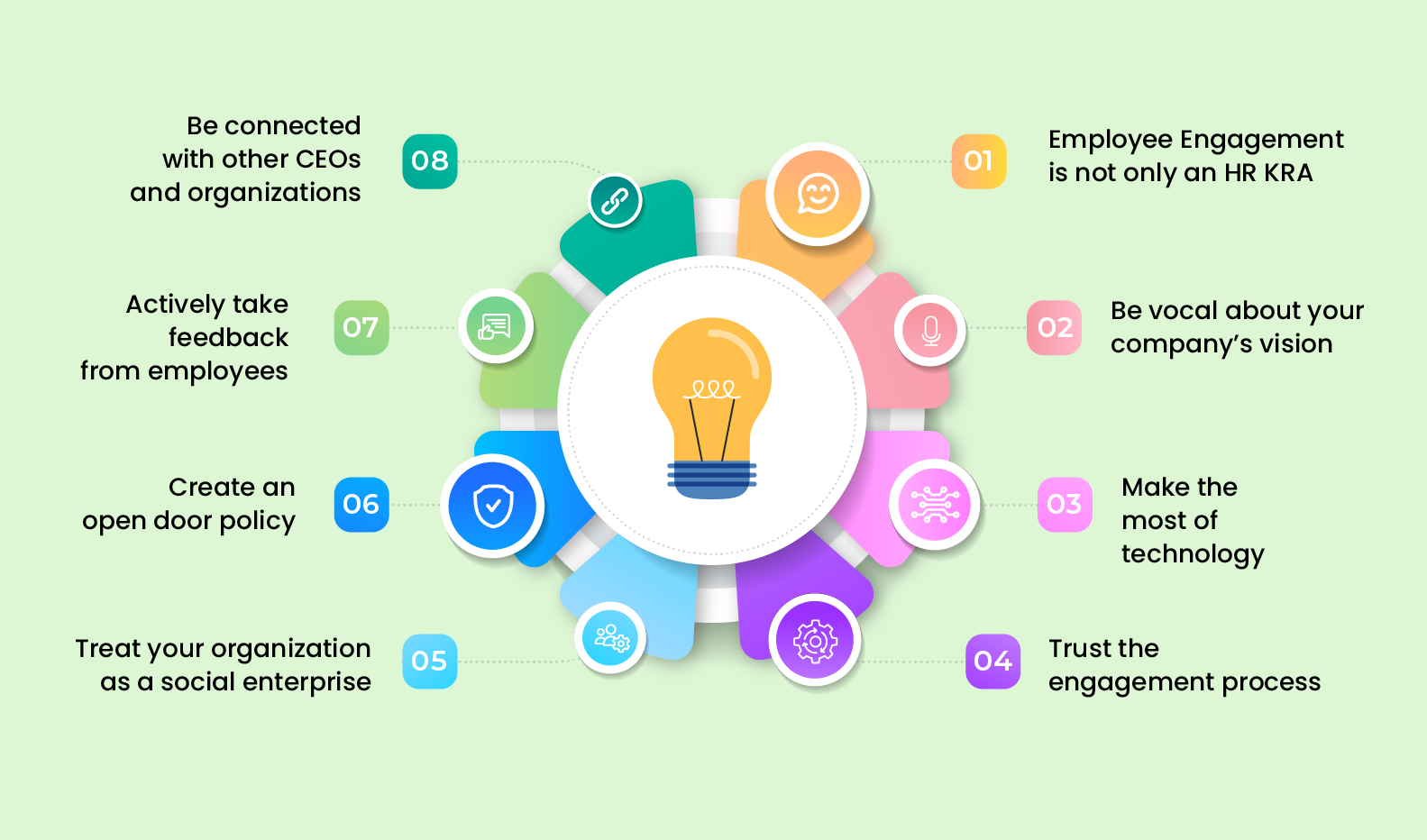It is a well-established fact that engaged employees are at the heart of an organization’s success. Consequently, a highly engaged workforce tops every chief executive officer’s (CEO’s) wish list. As increased productivity levels, higher revenues, and reduced employee turnover continue to be associated with high levels of employee engagement, no modern-day CEO can run a business without them. However, employee engagement is solely treated as the domain of the HR department. Given the current corporate landscape with distributed teams becoming the norm, it is not only an HR professional’s job to keep the employees engaged– the CEO’s role in employee engagement is equally paramount.
In this blog, we will look at the CEO’s role in employee engagement some tips on how CEOs can engage with their employees.
What is the chief executive officer’s role in employee engagement?
Let’s begin by asking a few questions: who drives employee engagement? Is it the managers, the HR heads, the work culture, or the leadership? And by leadership, here we mean the CEO. Employees normally see the organization and their CEO as one and the same. As a result, any successful or failed employee engagement initiative by the organization is cited as the success or failure of the CEO’s efforts.
Generally, for employees, CEOs are the determinants of most organizational changes, developments, successes, and failures. Evidently, a CEO’s role in employee engagement can make a huge difference. They are also highly responsible for influencing, impacting, and deriving culture by connecting with their employees. And aligning them to the company’s mission, values, and strategy, and building an environment of continual recognition turn leads to improved business results.
A study by Forbes suggests that 66% of underappreciated employees are more likely to leave an organization as compared to appreciated employees. With that statistics in mind, let’s look at some tips that emphasize how a CEO can engage with employees:

1. Impactful top down management
A healthy work-culture always stems from top down. For employee engagement to succeed, it is important that CEOs make it a part of their KRA. It is the CEOs responsibility to set employee engagement strategy in motion by prioritizing it, aligning it with company goals, and allocating resources for it. Making it part of the business strategy and giving your HR team and managers a clear direction is the primary role of a CEO in employee engagement.
Additionally, as a CEO, connecting with employees on the ground-level can make a big difference. Do remember that good leaders are always present on the front lines. The presence of a CEO can inspire trust among employees for their leadership and its values.
2. Invest in the right HR technologies
For a CEO to successfully and smoothly implement employee engagement programs, you must leverage technology. Being a part of the leadership, their schedule might not allow enough time to keep a daily track of the progress. With the help of employee engagement software, it is easier than ever for both startups and established enterprises to keep their employees engaged without investing in a lot of time or hiring new HR team members.
From running consistent employee engagement surveys, offering the right employee onboarding, training and scheduling one-on-one meetings with managers, an HR workflow automation tool can keep things on track across all departments and at scale. In addition to process automation, investing in the right HR technologies also helps you derive actionable insights from your employees to get a better grasp at what they expect from the organization and what enables them to do better work.
3. Share the company’s vision
The importance of the CEO’s interaction with employees is one of the most powerful methods of building trust. Employees most of the time are not clear about the ultimate mission of their organization. It is the role of a CEO to align the team with the mission and develop an understanding amongst them so they stay focused on the purpose and always aspire to achieve it.
For example, there is a company that wants to ship 20% more goods than they did last year. They want to achieve this target by the end of this season. The CEO of the said company can share the company’s vision by explaining how each employee’s contribution will help the company to achieve that and how important their contribution is to the company’s goals as a whole. If there is trust between the C-suite and employees, it increases productivity and allows employees to focus on what is important.
4. Work towards engagement continuously
Employee engagement is not a one-time event, it requires time, constant efforts and timely updates. A significant number of organization leaders would agree that they are investing significantly in elevating the engagement levels among the workforce.
However, expecting one or two employee engagement initiatives are going to bring a remarkable change in your workforce is unrealistic. It is a continual process that can be achieved by regularly connecting with employees and business associates. Try to schedule a town hall where the organization can discuss its achievements. You can also make this space for a rewards and recognition program where the leader acknowledges the hard work and efforts of their best-performing employees.
By simply treating the employees as more than a name in the organizational chart and building trust through continual communication, people will not only look forward to working for you but it can also aid in your organization’s retention strategies.
5. Treat your organization as a social enterprise
Act like a social enterprise that focuses more on the impact they have on society rather than monetary success. This might be a huge change in the organization, so start small. Try implementing practices that contribute to a purpose rather than solely promoting the revenue you aim to reach.
With the CEO communicating how they intend to bring a change in the current market and how the employees will be a key element in achieving it, can help in changing the perspective. Your employees will start to realize how meaningful their contribution is in organizational success. This also ties up well with you sharing the company’s mission statement, vision, goals and values transparently.
As a CEO, you may ask – How to treat my organization as a social enterprise? Corporate social responsibility (or CSR) is becoming a part of the core business strategy for many organizations. Employees feel more engaged if they sense that they are contributing to the betterment of society. So, by quite literally implementing a socially responsible angle to your business, your employees will focus on working towards creating an impact not only by achieving their KRAs but also by contributing to society.
“Employee engagement is not only a financial and business strategy but also a good practice to be followed. It not only helps businesses but also the personnel as they are more focused, motivated, and produce their best which in turn is beneficial for their careers. Fortunately, many businesses are including this in their primary strategy in recent times.”
Phil Strazzulla
CEO, Select software reviews
6. Create an open-door policy
An open-door policy encourages all managers and C-suite people to listen to their employees. The policy aims to collect constructive feedback from employees of varied approaches. This also encourages employees to voice their opinions and promotes the most optimal results in all aspects of the operation including growth and overall satisfaction.
An open-door policy aids in communication, which is crucial to creating a healthy work-culture. Management can respond better to issues and concerns when they are aware of them. And employees decide to share their honest feedback, it is the responsibility of the leadership to show that their opinions are respected and valued. This helps shape a trustworthy and productive workplace environment.
As a CEO, it is important to remember that your employees are the backbone of your company. As one of the most important CEO’s role in employee engagement, try not hold back to go above and beyond and keep the lines of communication open with them!
“I think that the top factor to retaining employees is to always be talking with them. You should not be a dark shadowy figure in the office and just seen as ‘the boss’ or ‘management’, you should be a part of the team and with them as much as you can be.”
Raymond Weitekamp
Founder and CEO, polySpectra.
7. Actively take feedback from employees
Employees actively notice any shift in their work environment. If your employees are feeling a negative shift, do not neglect their feedback as it may result in employee disengagement. Thus, feedback from employees can give a good idea of just how successful or unsuccessful the dealings may be in affecting an organization’s standing in the market.
Further, CEOs should encourage their staff members to suggest new ideas about potential projects and how to improve interactions with customers or internal stakeholders. By gathering fresh inputs that will help both the CEO and employees, commitment levels at work will rise along with engagement levels.
Ask employees about their thoughts on new products or services that you’re thinking of adding to your offer, or about potential deals in the works. Also make sure that as CEO, you give input into projects and initiatives by asking the team questions that could provide you with valuable insight on what they view as priorities. Allow employees to openly contribute and help boost their engagement levels.
8. Connect with other CEOs
For CEOs to build a tenacity on the employee engagement initiatives in their company. They need to be aware of what is happening in the other organizations related to the subject. Hence, building connections with CEOs from other enterprises becomes extremely crucial.
Connecting with other CEOs and learning what is working for them in terms of their employee engagement practices will provide valuable insights. It will also help in understanding their challenges and setbacks and how they kick back up. It also helps in creating social visibility in the industry.
“Companies that want to keep their employees engaged should recognize that they need to break away from the traditional strategies and structures of the past. A CEO who is willing to get out of his/her comfort zones and openly use digital tools themselves play an important role in driving positive culture change from the top down.”
Robin Brown
CEO at Vivipins
To Sum up
It’s easy to get busy in day-to-day operations, but it’s important to remember that your employees are the most valuable asset and they are the ultimate drivers of your business results.
A CEO’s role in employee engagement does not have to be on the back foot anymore. By implementing the right practices, leaders can create a work culture that encourages strong employee engagement. When org-leaders are committed to improving employee engagement, positive change becomes unstoppable.






